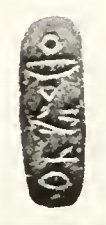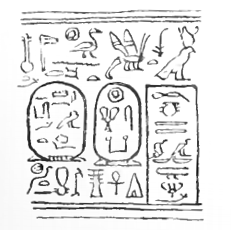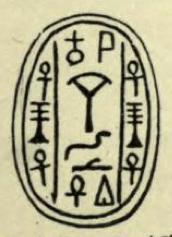
The Second Intermediate Period dates from 1700 to 1550 BC. It marks a period when ancient Egypt was divided into smaller dynasties for a second time, between the end of the Middle Kingdom and the start of the New Kingdom. The concept of a Second Intermediate Period generally includes the 13th through to the 17th dynasties, however there is no universal agreement in Egyptology about how to define the period.

Userkare Khendjer was a minor king of the early Thirteenth Dynasty of Egypt during the Middle Kingdom. Khendjer possibly reigned for four to five years, archaeological attestations show that he was on the throne for at least three or four years three months and five days. Khendjer had a small pyramid built for himself in Saqqara and it is therefore likely that his capital was in Memphis.

Djedhotepre Dedumose I was an Egyptian pharaoh of the Second Intermediate Period. According to egyptologists Kim Ryholt, Darrell Baker, Aidan Dodson and Dyan Hilton, he was a king of the 16th Dynasty. Alternatively, Jürgen von Beckerath, Thomas Schneider and Detlef Franke see him as a king of the 13th Dynasty.

The Sixteenth Dynasty of ancient Egypt was a dynasty of pharaohs that ruled the Theban region in Upper Egypt for 70 years.

Khaneferre Sobekhotep IV was one of the more powerful Egyptian kings of the 13th Dynasty, who reigned at least eight years. His brothers, Neferhotep I and Sihathor, were his predecessors on the throne, the latter having only ruled as coregent for a few months.

Merhotepre Sobekhotep was an Egyptian king of the late 13th Dynasty during the Second Intermediate Period.

Sekhemre Wahkhau Rahotep was an Egyptian pharaoh who reigned during the Second Intermediate Period, when Egypt was ruled by multiple kings. The Egyptologists Kim Ryholt and Darrell Baker believe that Rahotep was the first king of the 17th Dynasty.

Nebmaatre is the prenomen of a poorly attested ruler of the late Second Intermediate Period of Ancient Egypt. Nebmaatre may have been a member of the early 17th Dynasty and as such would have reigned over the Theban region. Alternatively, Jürgen von Beckerath believes that Nebmaatre was a ruler of the late 16th Dynasty.

Maaibre Sheshi was a ruler of areas of Egypt during the Second Intermediate Period. The dynasty, chronological position, duration and extent of his reign are uncertain and subject to ongoing debate. The difficulty of identification is mirrored by problems in determining events from the end of the Middle Kingdom to the arrival of the Hyksos in Egypt. Nonetheless, Sheshi is, in terms of the number of artifacts attributed to him, the best-attested king of the period spanning the end of the Middle Kingdom and the Second Intermediate period; roughly from c. 1800 BC until 1550 BC. Hundreds of scaraboid seals bearing his name have been found throughout the Levant, Egypt, Nubia, and as far away as Carthage, where some were still in use 1,500 years after his death.

Sekhemre Seusertawy Sobekhotep VIII was an ancient Egyptian ruler during the Second Intermediate Period whose exact chronological placement remains uncertain. He may have ruled over the Theban region in Upper Egypt. Scholars debate whether he belonged to the 13th, 16th, or 17th Dynasty. If Sobekhotep VIII was a king of the 16th Dynasty, it is thought that he is listed in the Turin Canon (11:2), which credits him with a 16-year reign.

Sehetepibre Sewesekhtawy was an Egyptian pharaoh of the 13th Dynasty during the early Second Intermediate Period, possibly the fifth or tenth king of the Dynasty.

Djedneferre Dedumose II was a native ancient Egyptian pharaoh during the Second Intermediate Period. According to egyptologists Kim Ryholt and Darrell Baker, he was a ruler of the Theban 16th Dynasty. Alternatively, Jürgen von Beckerath, Thomas Schneider and Detlef Franke see him as a king of the 13th Dynasty.

Sekhemre Sementawy Djehuty was a minor king reigning over parts of Upper Egypt during the Second Intermediate Period.

Seankhenre Mentuhotepi was an ancient Egyptian pharaoh during the fragmented Second Intermediate Period.

Sekhemkare Amenemhat Senebef was an Egyptian pharaoh of the early 13th Dynasty, often considered as the final part of the late Middle Kingdom or early Second Intermediate Period.

The Abydos Dynasty is hypothesized to have been a short-lived local dynasty ruling over parts of Middle and Upper Egypt during the Second Intermediate Period in Ancient Egypt. The Abydos Dynasty would have been contemporaneous with the Fifteenth and Sixteenth Dynasties, from approximately 1650 to 1600 BC. It would have been based in or around Abydos and its royal necropolis might have been located at the foot of the Mountain of Anubis, a hill resembling a pyramid in the Abydene desert, close to a rock-cut tomb built for pharaoh Senusret III.

Menkhaure Snaaib was an Egyptian pharaoh during the Second Intermediate Period between the Middle Kingdom and New Kingdom at the end of the Middle Bronze Age.

Wazad was an Egyptian pharaoh during the Second Intermediate Period. According to the Egyptologists Kim Ryholt and Darrell Baker, Wazad was a member of the 14th Dynasty of Egypt reigning c. 1700 BC. As a king of the 14th Dynasty, he would have reigned from Avaris over the eastern Nile Delta and possibly over the western Delta as well. The Memphis-based 13th Dynasty reigned over Middle and Upper Egypt at the same time. Alternatively, according to Jürgen von Beckerath and Wolfgang Helck, Wazad was a ruler of the 16th Dynasty and a vassal of the Hyksos 15th Dynasty. This view is debated in Egyptology, in particular because Ryholt and others have argued that the 16th Dynasty was an independent Theban kingdom rather than a vassal dynasty of the Hyksos.

Sewahenre Senebmiu is a poorly attested Egyptian pharaoh during the Second Intermediate Period, thought to belong to the late 13th Dynasty.
Merkare was an Egyptian pharaoh of the late 13th Dynasty of Egypt during the Second Intermediate Period reigning for a short while, some time between 1663 BC and 1649 BC.


















